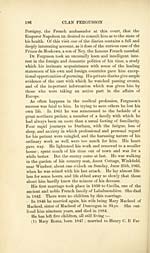Download files
Complete book:
Individual page:
Thumbnail gallery: Grid view | List view

FERGUSSONS IN ATHOLE 195
to say, of his patients consisted partly of families to which
he was introduced by Dr. Gooch, and partly of that highly-
gifted set of whom Sir Walter Scott and his son-in-law,
Lockhart, were the chief. At any rate, by the year 1830,
when he was thirty years old, he had attained an income of
£1000 per annum.
About this time King's College was opened for the express
purpose of combating the too liberal and, as it was thought,
perhaps irreligious or revolutionary tendencies of the London
University. The Chair of Midwifery was accepted by Fergu-
son, who had for his colleagues Herbert Mayo, Joseph Henry
Green, J. F. Daniell, Bissett Hawkins, Francis Hawkins, and
Partridge. He had been previously elected Physician to
the General Lying-in-Hospital in the York Road, where he
gathered materials for his work on puerperal fevers, which
was published by Murray in 1839.
He was now fully occupied in the busiest and most lucra-
tive practice, and found it expedient to resign his professor-
ship, in which he was succeeded by Dr. Arthur Farre.
Soon afterwards he was appointed ' Physician Accoucheur '
to the Queen, and in that capacity assisted at the births of
all the Royal children.
And now came a bold and hazardous, but well-designed
and entirely successful movement in his professional career.
He dropped the special ' midwifery ' department of his prac-
tice, and announced himself a physician in the largest sense.
This decision was attended with complete success. Society
accepted him as one of the greatest medical authorities. He
became ' Physician Extraordinary ' to the Queen, and thence-
forward the amount of his occupation was only limited by
his power of undertaking it. ' He was more consulted per-
haps ' (says the Medical Times and Gazette) ' than any other
living man in all the weightiest cases of the world. No
physician was so well known, not merely to all the great
families of this Empire, of whatever side in politics, bishops,
lords, dignitaries of every grade, but to the crowned heads
of Europe.' A remarkable instance in illustration of this
last statement is his visit to Paris in the year 1856, in
consequence of an intimation made to him through M. de
to say, of his patients consisted partly of families to which
he was introduced by Dr. Gooch, and partly of that highly-
gifted set of whom Sir Walter Scott and his son-in-law,
Lockhart, were the chief. At any rate, by the year 1830,
when he was thirty years old, he had attained an income of
£1000 per annum.
About this time King's College was opened for the express
purpose of combating the too liberal and, as it was thought,
perhaps irreligious or revolutionary tendencies of the London
University. The Chair of Midwifery was accepted by Fergu-
son, who had for his colleagues Herbert Mayo, Joseph Henry
Green, J. F. Daniell, Bissett Hawkins, Francis Hawkins, and
Partridge. He had been previously elected Physician to
the General Lying-in-Hospital in the York Road, where he
gathered materials for his work on puerperal fevers, which
was published by Murray in 1839.
He was now fully occupied in the busiest and most lucra-
tive practice, and found it expedient to resign his professor-
ship, in which he was succeeded by Dr. Arthur Farre.
Soon afterwards he was appointed ' Physician Accoucheur '
to the Queen, and in that capacity assisted at the births of
all the Royal children.
And now came a bold and hazardous, but well-designed
and entirely successful movement in his professional career.
He dropped the special ' midwifery ' department of his prac-
tice, and announced himself a physician in the largest sense.
This decision was attended with complete success. Society
accepted him as one of the greatest medical authorities. He
became ' Physician Extraordinary ' to the Queen, and thence-
forward the amount of his occupation was only limited by
his power of undertaking it. ' He was more consulted per-
haps ' (says the Medical Times and Gazette) ' than any other
living man in all the weightiest cases of the world. No
physician was so well known, not merely to all the great
families of this Empire, of whatever side in politics, bishops,
lords, dignitaries of every grade, but to the crowned heads
of Europe.' A remarkable instance in illustration of this
last statement is his visit to Paris in the year 1856, in
consequence of an intimation made to him through M. de
Set display mode to:
![]() Universal Viewer |
Universal Viewer | ![]() Mirador |
Large image | Transcription
Mirador |
Large image | Transcription
Images and transcriptions on this page, including medium image downloads, may be used under the Creative Commons Attribution 4.0 International Licence unless otherwise stated. ![]()
| Histories of Scottish families > Records of the clan and name of Fergusson, Ferguson and Fergus > (239) Page 195 |
|---|
| Permanent URL | https://digital.nls.uk/95329031 |
|---|
| Description | A selection of almost 400 printed items relating to the history of Scottish families, mostly dating from the 19th and early 20th centuries. Includes memoirs, genealogies and clan histories, with a few produced by emigrant families. The earliest family history goes back to AD 916. |
|---|

